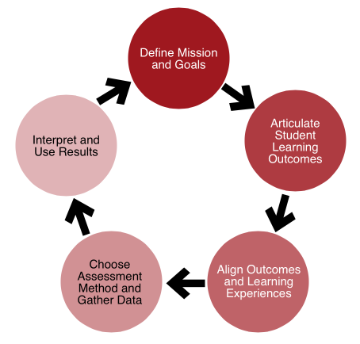The first step in the assessment process is for a program or department to define their mission and learning goals.

A new program or a program without an assessment process will always start with defining the program's mission and goals. From the mission and goals, the student learning objectives are created. The learning objectives drive the assessment process. The faculty and/or staff should ensure that students have learning opportunities or experiences to meet the learning objectives. Once an assessment method is chosen and the data is collected, the results need to be interpreted. Given the results, the program may want to make changes to the curriculum and gather data again to close the loop.
Once a department or program has defined its mission and goals, the next step is to articulate student learning outcomes. That is, what will students from the department be able to know or do after graduating? Or how will students grow or change in their attitudes and behaviors after completing the program?
The learning outcomes drive the learning experiences. Once the learning outcomes have been created, students must be given the opportunity to attain these outcomes, therefore the next step is to align the learning outcomes with learning experiences (i.e., the curriculum).
Once learning outcomes and learning experiences have been mapped, a program can now choose an assessment method and gather data. The program will need to decide what type of data they want to collect, how to collect this data and from who.
Once data is collected, the final step is to interpret and use assessment results. This could be argued as the most important step in the assessment process. Programs can address deficencies discovered through assessment by making program changes. They also can see what they are doing well and provide strong evidence of student learning.
As programs work through the steps of the assessment process, they should also create an assessment plan.
The assessment plan is a document or a chart that contains the following information:
- How will each outcome be assessed? What direct assessment and indirect assessment evidence will be collected?
- When and how often will you assess each outcome?
- How will the evidence be collected?
- How will the evidence be assessed?
- Who will reflect on the results and decide if and how to close the loop (whole department, Assessment Committee, Curriculum Committee, relevant subset of the faculty?)? When?
- How will results and closing the loop actions be documented?

Each year assessment studies and the documentation of loop closing will be summarized in our annual assessment report.
**Adapted from handout prepared by Marry Allen for WASC Leadership Academy, 2014.